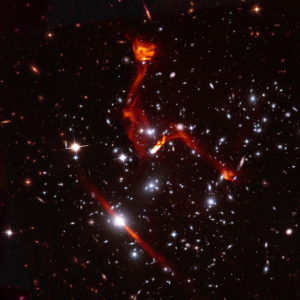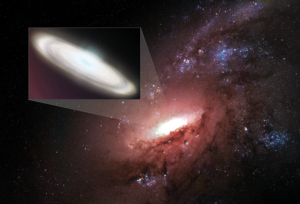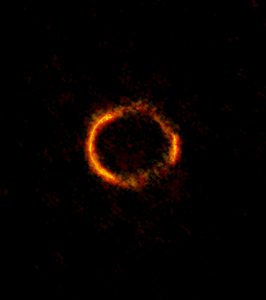Astronomers using the VLA took advantage of the gravitational lensing provided by a distant cluster of galaxies to detect an even more-distant galaxy that probably is the faintest radio-emitting object ever found.
Select :
aasactive galactic nucleusALMAanniversaryARDCasteroidasteroidsAtacamaAtacama Large Millimeter/submillmeter arrayAUIaui programAUI Scholarshipawardsbaselinebinarybinary starsblack holeblack holesblazarBroader Impactsbrown dwarfCaltechcasaCDLcensusCentral Development LaboratoryCepheus acfachandracoma berenicesComa clustercometscosmic explosioncosmologycryoCSOdark matterdead galaxyDecadal Surveydeep fielddeep field imagingdftaudigital backenddistant galaxydiversityearly universeEHTEMSequityeventexoplanetexoplanetsfast radio burstFast Radio Burstsfirst fringesflarefotaufrbfringesfundinggalaxiesgalaxies mergergalaxygalaxy clustergalexgamma ray burstgbogbtgravitational lensgravitational wavesgreen bank observatorygreen bank telescopeH20HAM Radiohelical magnetic fieldhonorsHubbleHugheshvachw2hydrogenimage contestinclusioninternational women's dayIoJansky FellowshipsJansky Lecturejetjet collimationjetsJupiterLeroyLGBTlocal oscillatorlow noise amplifierm83M87magnetarMagnetarsmagnetic fieldsmaserMilky Waymolecular cloudsmoumtexNACnasaNational Astronomy ConsortiumNational Science Foundationnear earth objectsNEOsneutron starsneutron-star mergernglcngVLANINENMnraoNRQZNSFNSF NRAOODIopen houseOrionparkes radio observatorypawseypeoplePHANGSplanetary defensePlanetary Radarplanetary scienceplasmaPostdoctoral researchPRIDEprotoplanetary diskprotoplanetsprotostarprotostarsprotostellar jetPROVOCAproxima centauripulsarqorvoquasarradarradio telescoperam pressure strippingraytheonreceiverreceiver upgradeREUrixindustriesSchinnererscholarshipscience casesSETIsgrASMBHsofiasoftwareSolar Systemspectrumspiral galaxiesstar deathstar factorystar formationstarbirthstarsstellar flarestellar nurseriesSTEMsummer researchsupernovasupernova remnanttidal disruption eventstradestradesmenunmupgradeusnovery large arrayvery long baseline arrayviaVLAvla open housevlassVLBAvlbivndawaterxkaxray


Quasar Discovery Sets New Distance Record
Astronomers using the Atacama Large Millimeter/submillimeter Array (ALMA), along with other telescopes, have discovered the most distant quasar yet found. The bright quasar, powered by a supermassive black hole at the core of a galaxy, is seen as it was only 670 million years after the Big Bang, and is providing valuable clues about how such huge black holes and their host galaxies formed in the early Universe.

New Distance Measurements Bolster Challenge to Basic Model of Universe
A cosmic measurement technique independent of all others adds strong evidence pointing to a problem with the current theoretical model describing the composition and evolution of the Universe.

ALMA Sees Einstein Ring in Stunning Image of Lensed Galaxy
Astronomers have observed a cosmic ring with the help of ALMA.





